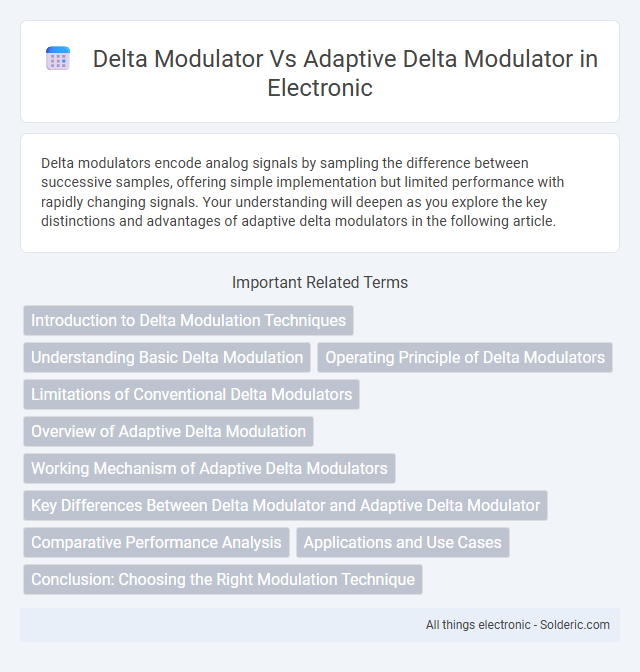Delta modulators encode analog signals by sampling the difference between successive samples, offering simple implementation but limited performance with rapidly changing signals. Your understanding will deepen as you explore the key distinctions and advantages of adaptive delta modulators in the following article.
Comparison Table
| Feature | Delta Modulator (DM) | Adaptive Delta Modulator (ADM) |
|---|---|---|
| Step Size | Fixed | Variable, adapts to input signal |
| Performance | Simple but prone to slope overload distortion | Improved performance, reduces slope overload |
| Complexity | Low | Moderate to High |
| Signal Quality | Lower quality for rapidly changing signals | Better quality, handles dynamic signals efficiently |
| Applications | Basic voice transmission, low-bandwidth systems | High-quality audio transmission, voice codecs |
| Power Consumption | Lower | Higher due to adaptation logic |
| Error Types | Slope overload, granular noise | Reduced slope overload, granular noise persists |
Introduction to Delta Modulation Techniques
Delta Modulation (DM) is a simple, efficient analog-to-digital conversion technique that encodes the difference between successive samples, reducing data size while preserving signal integrity. Adaptive Delta Modulation (ADM) enhances this by dynamically adjusting the step size based on signal variations, improving accuracy in rapidly changing signals and minimizing distortion. Your choice between DM and ADM depends on the trade-off between implementation complexity and the need for higher fidelity in varying signal environments.
Understanding Basic Delta Modulation
Basic Delta Modulation (DM) encodes analog signals by tracking their changes with a fixed step size, representing differences as binary signals to simplify digital conversion. In contrast, Adaptive Delta Modulation (ADM) dynamically adjusts the step size based on the signal's slope, improving accuracy and reducing distortion during rapid changes. This adaptive approach enhances performance in variable signal environments by optimizing resolution and minimizing quantization noise.
Operating Principle of Delta Modulators
Delta Modulators operate by encoding the difference between successive samples into a single bit, effectively approximating the analog input through a series of incremental steps. Adaptive Delta Modulators enhance this process by dynamically adjusting the step size based on the signal's rate of change, improving accuracy during rapid transitions and reducing granular noise during slow variations. This adaptive mechanism ensures better signal tracking and more efficient encoding compared to fixed-step delta modulators.
Limitations of Conventional Delta Modulators
Conventional Delta Modulators face challenges such as granular noise and slope overload distortion, which degrade signal quality during slow or rapid changes in the input. These modulators use a fixed step size, limiting their ability to adapt to varying signal amplitudes, resulting in increased errors and reduced dynamic range. Your communication system can benefit from Adaptive Delta Modulators, which adjust the step size to minimize these limitations and enhance overall performance.
Overview of Adaptive Delta Modulation
Adaptive Delta Modulation (ADM) improves upon standard Delta Modulation by dynamically adjusting the step size in response to the input signal characteristics, allowing for more accurate signal representation and reduced quantization noise. This adaptability enhances performance in varying signal environments, providing better resolution during rapid signal changes while conserving data during slower variations. Your communication system benefits from ADM through increased fidelity and efficient bandwidth usage compared to fixed-step Delta Modulation.
Working Mechanism of Adaptive Delta Modulators
Adaptive delta modulators improve upon traditional delta modulators by dynamically adjusting the step size of the quantizer based on the input signal's variations, enhancing signal tracking accuracy and reducing distortion. This mechanism allows the modulator to increase the step size during rapid input changes and decrease it when the signal is relatively constant, optimizing both resolution and bandwidth efficiency. By continuously tailoring the step size, adaptive delta modulators achieve better performance in terms of signal-to-noise ratio and overall fidelity in digital communication systems.
Key Differences Between Delta Modulator and Adaptive Delta Modulator
Delta Modulators use a fixed step size for quantizing signals, resulting in simpler implementation but potential slope overload and granular noise. Adaptive Delta Modulators dynamically adjust the step size based on the input signal's variations, improving accuracy and reducing distortion during rapid signal changes. Your choice between these modulators depends on the required trade-off between complexity, signal fidelity, and responsiveness.
Comparative Performance Analysis
Delta modulators provide a simple and efficient method for analog-to-digital conversion but often suffer from slope overload distortion and granular noise, limiting their performance in rapidly changing signals. Adaptive delta modulators dynamically adjust their step size based on the signal characteristics, significantly reducing distortion and improving tracking ability for complex or high-frequency inputs. Your choice between the two depends on the application's requirement for accuracy and signal dynamics, with adaptive delta modulation offering superior performance in terms of signal fidelity and adaptability.
Applications and Use Cases
Delta modulators are primarily used in low bit-rate voice communication systems and simple data compression scenarios where constant step size is sufficient for encoding signals with limited variability. Adaptive delta modulators enhance performance in high-fidelity audio and speech transmission by dynamically adjusting the step size to accommodate rapid signal changes, reducing distortion and slope overload errors. Applications of adaptive delta modulators include advanced telecommunication systems, digital hearing aids, and other real-time signal processing environments requiring improved accuracy over conventional delta modulation.
Conclusion: Choosing the Right Modulation Technique
Delta modulator offers simplicity and low bandwidth usage, making it suitable for applications requiring basic analog-to-digital conversion with minimal hardware complexity. Adaptive delta modulator improves performance by dynamically adjusting the step size, reducing quantization noise and enhancing signal fidelity, especially in varying signal conditions. To optimize Your system's efficiency and accuracy, select delta modulation for straightforward tasks and adaptive delta modulation when higher quality and adaptability are essential.
Delta modulator vs Adaptive delta modulator Infographic

 solderic.com
solderic.com